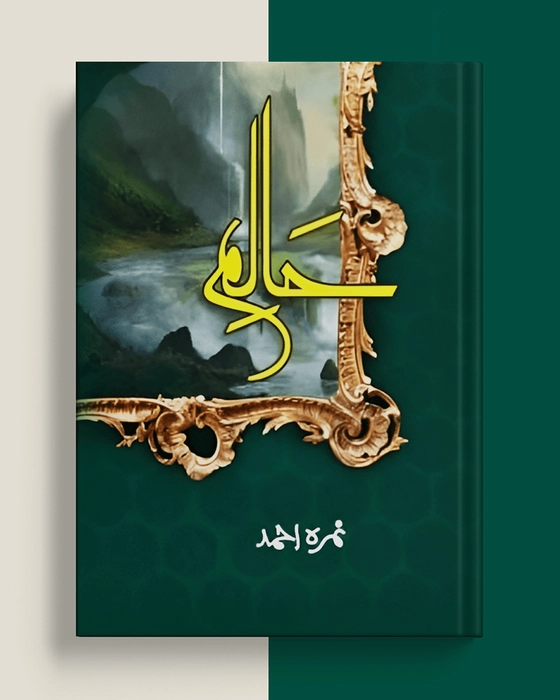
Overview of “Haalim”
“Haalim” is a serialized novel that was published in episodes in a monthly digest. It quickly garnered a large readership due to its engaging plot and multi-dimensional characters. The novel’s narrative is rich with suspense, mystery, and thought-provoking themes, making it a standout work in contemporary Urdu literature.
Haalim novel-pdf-Download-(pantherbolt.com)
Plot Summary
“Haalim” revolves around the lives of two main characters, Talia Murad and Adam Bin Muhammad, whose fates are intertwined through a series of extraordinary events. The story begins with Talia, a young woman with a troubled past, who discovers her ability to travel through time. This discovery sets her on a path of self-discovery and redemption.
Adam, a politician with a strong sense of justice, is introduced as a key figure fighting against corruption and injustice in his country. His life becomes entangled with Talia’s as they both navigate the complexities of their personal lives and the larger political landscape.
The novel’s plot is divided into multiple parts, each exploring different timelines and events that shape the characters’ journeys. The time travel element adds a layer of complexity to the narrative, allowing the author to explore themes of destiny, choice, and the impact of past actions on the present and future.
Main Characters
- Talia Murad
- Talia is a complex character with a troubled past and a unique ability to travel through time. Her journey is one of self-discovery, redemption, and transformation. She evolves from a lost, confused individual into a strong, determined woman with a clear sense of purpose.
- Adam Bin Muhammad
- Adam is a principled politician dedicated to fighting corruption and bringing about positive change in his society. His character is marked by integrity, strength, and a deep sense of justice. His relationship with Talia and his role in the larger political narrative are central to the story.
- Supporting Characters
- The novel features a rich cast of supporting characters, each contributing to the narrative’s depth and complexity. These characters include family members, political allies and adversaries, and individuals from different timelines who influence Talia and Adam’s journeys.
Themes and Motifs
- Time Travel and Destiny
- The concept of time travel is central to “Haalim,” allowing the exploration of themes like destiny, fate, and the consequences of our actions. The novel delves into how changing the past can impact the present and future, raising questions about predestination and free will.
- Political Intrigue and Corruption
- The political landscape of the novel is rife with intrigue, corruption, and power struggles. Adam’s fight against these issues reflects real-world societal challenges and the ongoing struggle for justice and transparency in governance.
- Personal Growth and Redemption
- Talia’s journey is one of personal growth and redemption. Her ability to travel through time becomes a metaphor for her inner transformation as she confronts her past and seeks to make amends for her mistakes.
- Love and Relationships
- The novel explores various dimensions of love and relationships, from the romantic bond between Talia and Adam to the familial ties that shape their identities. These relationships are tested and strengthened through the challenges they face.
- Cultural and Social Commentary
- “Haalim” offers a commentary on cultural and social issues, particularly those related to gender roles, societal expectations, and the struggle for personal freedom. The characters’ experiences reflect broader societal dynamics, encouraging readers to reflect on their own cultural contexts.
Literary Analysis
Nimra Ahmed’s writing in “Haalim” is characterized by its intricate plotting, rich character development, and the seamless integration of various genres. The novel combines elements of science fiction, political thriller, and romance, creating a unique and engaging reading experience.
The narrative structure, with its shifts between different timelines and perspectives, adds complexity to the story while maintaining coherence and suspense. Nimra Ahmed’s use of symbolism and metaphors enhances the thematic depth of the novel, making it a thought-provoking read.
Cultural and Social Context
“Haalim”
Haalim reflects many cultural and social dynamics prevalent in contemporary Pakistani society. Through its characters and their struggles, the novel addresses issues such as corruption, the quest for justice, and the role of women in society. The time travel element allows the author to juxtapose different eras, highlighting changes and continuities in social norms and values.
Critical Reception
“Haalim” has been widely praised by readers and critics alike for its innovative storyline and complex characters. The novel’s blend of science fiction and political thriller elements, coupled with its deep emotional and philosophical undertones, has made it a standout work in Urdu literature. Readers have appreciated the novel’s ability to keep them engaged and guessing until the very end.
Critics have noted Nimra Ahmed’s skillful storytelling and her ability to tackle complex themes with sensitivity and depth. The novel’s exploration of time travel and its impact on the characters’ lives has been particularly lauded for its originality and execution.
Impact and Legacy
The impact of “Haalim” extends beyond its immediate readership. The novel has inspired discussions on various social and political issues, encouraging readers to reflect on their own lives and the world around them. Its success has also paved the way for more experimental and genre-blending works in Urdu literature.
“Haalim” has further solidified Nimra Ahmed’s reputation as one of the most influential contemporary Urdu writers. Her ability to create compelling narratives that resonate with readers on multiple levels ensures that her works will be remembered and cherished for years to come.
Conclusion
“Haalim” is a remarkable achievement in Urdu literature, offering a rich and multifaceted narrative that combines elements of time travel, political intrigue, and personal transformation. Nimra Ahmed’s skillful storytelling and profound insights into human nature make the novel a compelling and thought-provoking read. Through the journeys of Talia and Adam, readers are encouraged to explore themes of destiny, justice, and the power of personal growth.
In conclusion, “Haalim” is not just a novel; it is an exploration of the human experience, a reflection on societal challenges, and a testament to the enduring power of faith, love, and perseverance. Nimra Ahmed has created a literary masterpiece that continues to inspire and captivate readers, ensuring its place as a significant work in contemporary Urdu literature.

